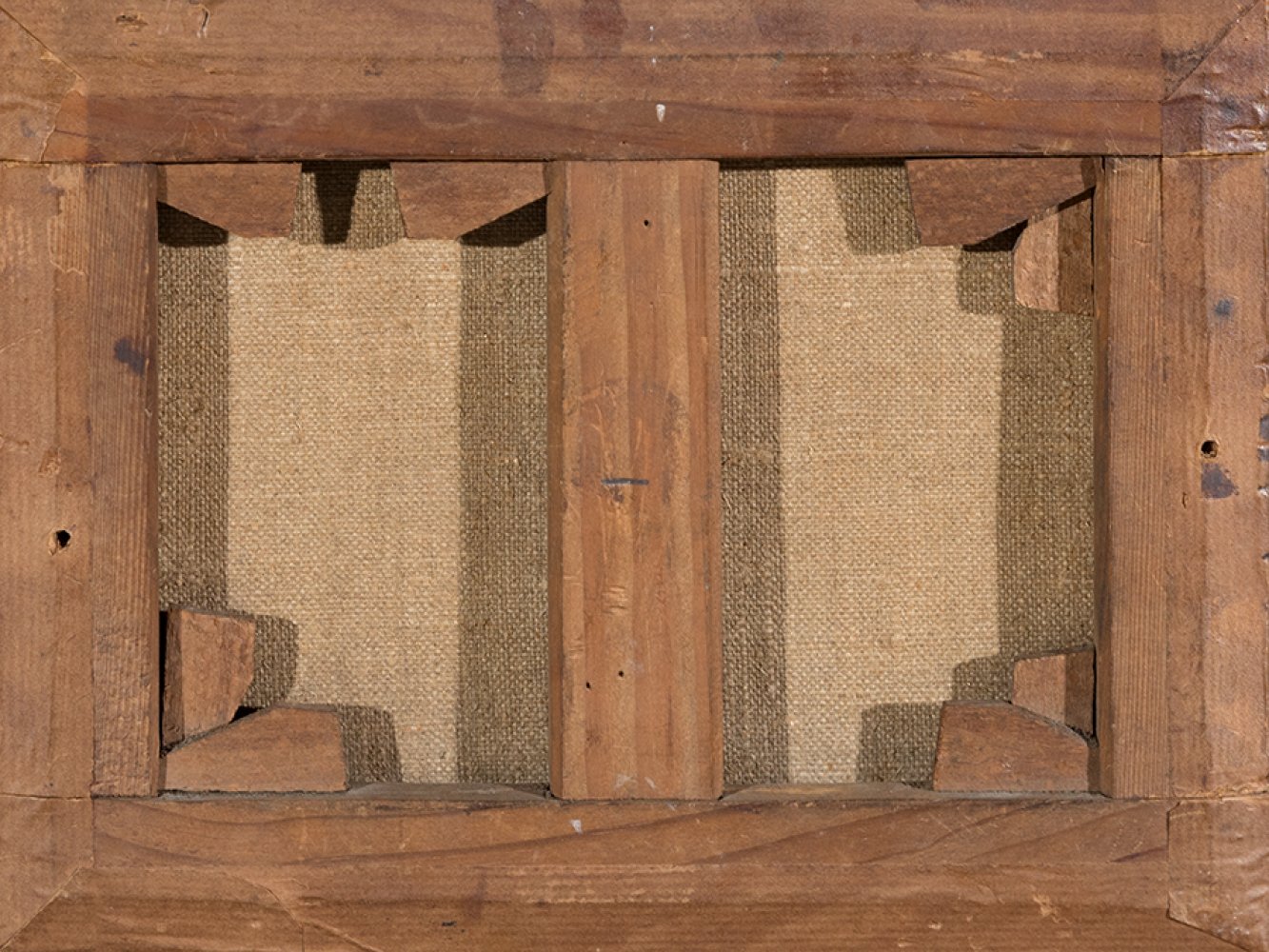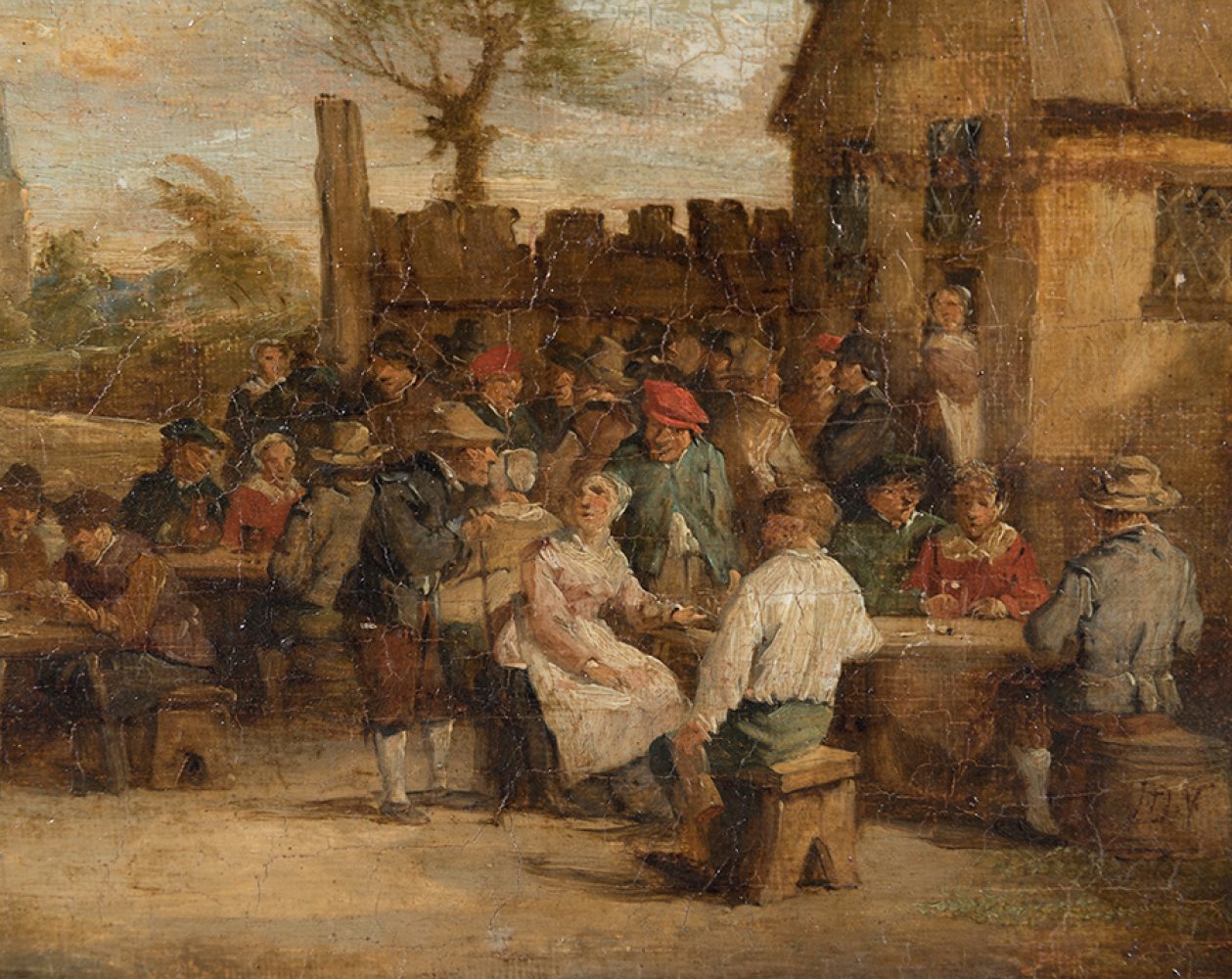11
DAVID TENIERS "The Young Man" (Antwerp, ca. 1610 - Brussels, 1690)."Kermesse".Oil on canvas.
"Kermesse".
Oil on canvas. Relined.
Attached report issued by the art dealer Jacques Helft (France, 1891 -1980).
With repainting and restorations.
Signed in the lower right area (barrel).
Measurements: 16 x 21 cm.
The canvas shows a rural scene in which some peasants celebrate a meal and different games in front of several houses. Thus recreating a stylistic pattern typical of the genre scenes by David Teniers (Antwerp, 1610 - Brussels, 1690). The scene features some of the pictorial devices popularised by the young David Teniers, who succeeded in revitalising the genre. In depicting these popular festivals, Teniers departed from the aesthetic and compositional schemes of Jan Brueghel "the Elder", repeating the same idyllic vision of the peasant world that was also widely used in Flemish literature of the time. He depicted the Kermes or Kermesse, the name given to neighbourhood festivals with food and drink stalls, where games of skill, children's games, raffles and artistic performances were held.
The son of David Teniers I, in his youth he remained faithful to his father's style. However, he soon specialised in genre painting, which was closely linked to the Flemish tradition. In 1638 he joined the Guild of Saint Luke, of which he later became dean. Among his patrons were the Bishop of Ghent and Archduke Leopold William. Teniers was also the artistic director of the archduke's collection, a position that included not only the conservation of paintings but also the responsibility for choosing and acquiring new works for what was one of the most important collections of 17th-century painting. This gave the painter the opportunity to become acquainted with and study at first hand works by both contemporary and earlier masters of various schools and genres. In 1651 he moved to Brussels on the occasion of his appointment as court painter, a post he retained with the arrival of the new archduke, John Joseph of Austria. He was free to work for other patrons, including the greatest art connoisseurs of the 17th century: Christina of Sweden, William II of Orange and Philip IV. Supported by the latter, in 1669 he succeeded in realising his project to create the Antwerp Academy. His influence extended into the 18th century, and his works formed part of the collections of the first Spanish Bourbons. His compositions were copied in tapestries that adorned the royal palace in Madrid, giving rise to a very popular genre known as "a la Teniers". Works by Teniers can be found in the most important museums in the world, including the Prado, the Hermitage, the Louvre, the Metropolitan in New York, the National Galleries in London, Washington and Prague, the Rijksmuseum, the Royal Collection in London, the Ashmolean in Oxford, the Poldi Pezzoli in Milan, the Museum of Western Art in Tokyo, the Thyssen-Bornemisza Museum, and the Fine Arts Museums in Brussels, Vienna, Antwerp and Dresden.
"Kermesse".
Oil on canvas. Relined.
Attached report issued by the art dealer Jacques Helft (France, 1891 -1980).
With repainting and restorations.
Signed in the lower right area (barrel).
Measurements: 16 x 21 cm.
The canvas shows a rural scene in which some peasants celebrate a meal and different games in front of several houses. Thus recreating a stylistic pattern typical of the genre scenes by David Teniers (Antwerp, 1610 - Brussels, 1690). The scene features some of the pictorial devices popularised by the young David Teniers, who succeeded in revitalising the genre. In depicting these popular festivals, Teniers departed from the aesthetic and compositional schemes of Jan Brueghel "the Elder", repeating the same idyllic vision of the peasant world that was also widely used in Flemish literature of the time. He depicted the Kermes or Kermesse, the name given to neighbourhood festivals with food and drink stalls, where games of skill, children's games, raffles and artistic performances were held.
The son of David Teniers I, in his youth he remained faithful to his father's style. However, he soon specialised in genre painting, which was closely linked to the Flemish tradition. In 1638 he joined the Guild of Saint Luke, of which he later became dean. Among his patrons were the Bishop of Ghent and Archduke Leopold William. Teniers was also the artistic director of the archduke's collection, a position that included not only the conservation of paintings but also the responsibility for choosing and acquiring new works for what was one of the most important collections of 17th-century painting. This gave the painter the opportunity to become acquainted with and study at first hand works by both contemporary and earlier masters of various schools and genres. In 1651 he moved to Brussels on the occasion of his appointment as court painter, a post he retained with the arrival of the new archduke, John Joseph of Austria. He was free to work for other patrons, including the greatest art connoisseurs of the 17th century: Christina of Sweden, William II of Orange and Philip IV. Supported by the latter, in 1669 he succeeded in realising his project to create the Antwerp Academy. His influence extended into the 18th century, and his works formed part of the collections of the first Spanish Bourbons. His compositions were copied in tapestries that adorned the royal palace in Madrid, giving rise to a very popular genre known as "a la Teniers". Works by Teniers can be found in the most important museums in the world, including the Prado, the Hermitage, the Louvre, the Metropolitan in New York, the National Galleries in London, Washington and Prague, the Rijksmuseum, the Royal Collection in London, the Ashmolean in Oxford, the Poldi Pezzoli in Milan, the Museum of Western Art in Tokyo, the Thyssen-Bornemisza Museum, and the Fine Arts Museums in Brussels, Vienna, Antwerp and Dresden.
9th November - Old Masters
Sale Date(s)
Venue Address
General delivery information available from the auctioneer
Setdart offers Worldwide shipping
PICK UP IN ROOM: You can come and pick up your lots in our offices (Barcelona, Madrid or Valencia). At the moment of the withdrawal, you will be able to accept the current conditions of the lot by means of a document that you will sign.
YOU CAN SEND ANOTHER PERSON TO PICK UP: This person must present a signed authorization that you can find in our web page by accessing from BUY AT SETDART- LOGISTICS-DOWNLOAD AUTHORIZATION DOCUMENT. You can also send an e-mail with the requested data in AUTHORIZATION DOCUMENT to admin@setdart.com
Important Information
25% buyer´s premium
OR
21% buyer´s premium at www.setdart.com
Terms & Conditions
The maximum period to pay the lots is 7 working days. You can pay either via bank transfer or with credit card through our platform www.setdart.com (we only accept VISA or Mastercard).
BUYER´S PREMIUM: 22% Hammer price + 21% VAT from the buyer´s premium
If your piece has more than 100 years, our Ministry of Culture requires an export certificate in order for the piece to leave the country. Note that if the piece goes inside the EU, there is no cost for the export certificate. If the piece goes outside the EU, there is a cost for the export certificate. You can find more information in our Ministry of Culture website: https://www.culturaydeporte.gob.es/en/cultura/patrimonio/exportacionimportacion/exportacion/tasas.html
INQUIRIES: admin@setdart.com
Setdart guides you through the entire process, from the time of award to the day you receive your lot. Our logistics team will be happy to manage your transport, and will advise you on the best shipping method with professionals from the sector used to handling works of art and jewelry.
WE OFFER WORLDWIDE DOOR TO DOOR SHIPPING
PICK UP IN ROOM: You can come and pick up your lots in our offices. At the moment of the withdrawal, you will be able to accept the current conditions of the lot by means of a document that you will sign.
YOU CAN SEND ANOTHER PERSON TO PICK UP: This person must present a signed authorization that you can find in our web page by accessing from BUY AT SETDART-LOGISTICS-DOWNLOAD AUTHORIZATION DOCUMENT. You can also send an e-mail with the requested data in AUTHORIZATION DOCUMENT to admin@setdart.com
SETDART IS NOT RESPONSIBLE FOR THE STATE OF THE PARTS ONCE THEY LEAVE OUR FACILITIES. MRW SHIPMENTS: Once the payment is made, your lot will be packed for shipment, the logistics department will send you an e-mail notifying you of the day it leaves our warehouse, changes of address cannot be made after receiving this e-mail.
INSURANCE INCIDENTS: Coverage for the value of the auction up to 3000 ? per shipment, if the value of the auction is higher, Setdart will send you a quote including the additional insurance. The insurance company WILL NOT BE RESPONSIBLE FOR THE SHIPMENT THAT EXCEEDS THAT AMOUNT AND IS NOT FULLY INSURED. MRW INCIDENTS: Maximum notification 48 hours after receipt, after which the insurance company WILL NOT BE RESPONSIBLE AND NO CLAIMS WILL BE ACCEPTED.
E-MAIL LOGISTICS: logistica@setdart.com
PICK UP YOUR MESSAGES: You can send your own messaging, prior notice via e-mail that your shipment is ready, please note 3 or 4 days in advance. This type of shipment is packaged so Setdart will provide you with a quote.
EXPENSES FOR STORAGE: We inform you that if the purchased lot is not picked up within a month, you will be charged 30€ per week per lot. Setdart Online S.L., owner of the web site "setdart.com", "setdart.net" and "setdart.org", acts as a company of Spanish nationality inscribed in the Volume 36955, sheet 182, page B-293056 of the Mercantile Registry, with registered office at Calle Aragó












